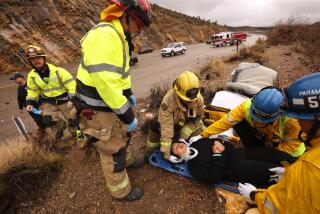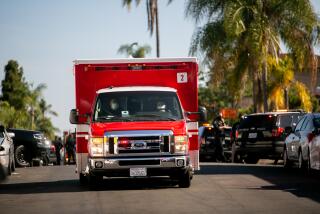Commentary : Insiderâs View of Hospital Trauma Care
Regionalization of trauma care in San Diego County has been the subject of much media attention over the last year, with most of that attention focused on the designation of hospitals as trauma centers and the intense competition for designation.
Little has been written about what goes on âin the trenchesâ of these hospitals once designation takes place, or about what trauma surgeons do that requires that they be âin houseâ 24 hours a day, seven days a week.
Trauma surgeons have completed general surgery residency training programs, just like the surgeon who might remove your appendix or gall bladder. They may also have additional training, but what sets these âadrenaline junkiesâ apart is not training, but an interest in managing acute surgical emergencies.
Often that management involves surgery of the abdomen or chest, such as in the patient who has been stabbed or has sustained a gunshot wound. Other times it involves rapidly administering intravenous fluids and blood to accident victims to prepare them for surgery by an orthopedist or neurosurgeon.
Always it involves rapid decision-making.
Once they are stabilized and treated for their injuries, trauma patients present unique problems requiring hospitalization in intensive care units.
The care of severely injured patients, during this stage, often requires a cadre of doctors from diverse fields. The trauma surgeon must integrate the input of these specialists into an organized plan. To illustrate these points, I would like to draw on my experience as a trauma surgeon at the UC San Diego Medical Center.
My day begins with rounds. This is done with the residents, interns and medical students, and always begins with our sickest patients--those hospitalized in the trauma intensive care unit. We examine the patients, review their X-rays, vital signs and laboratory data, and make decisions regarding therapy. Depending on the number of patients, rounds and the associated work can take up to five hours to complete.
Rounds can be interrupted at any time by the arrival of an injured patient, although this is rare because the majority of trauma occurs after dark.
Announcement of a new arrival comes to members of the trauma team through a radio pager. We respond to the receiving area and, once there, receive information about the patient, such as the mechanism of injury, the vital signs, suspected injuries and the estimated time of arrival.
We use this time to check equipment, assign tasks to support personnel, and anticipate any needs the patient may have, relying on the information that we have received. This time of preparation was invaluable when we were faced with treating victims of the San Ysidro massacre. We knew that we would be receiving multiple casualties and were given precious moments to mobilize our second and third operating teams.
Once the patient arrives, a report is given to us by the personnel involved in the transportation of the victim. They update the information we had previously received and inform us of any therapy carried out en route. Management of the patient is then entrusted to us, and we proceed expeditiously. The patientâs airway is assured, intravenous lines are started, blood is drawn and the patient is rapidly examined. The pace is brisk and often intense, especially if the patient has unstable vital signs.
Depending on our assessment of the injuries, X-rays are taken and diagnostic tests performed. In patients with penetrating injuries, such as those from the San Ysidro tragedy, management is relatively straightforward because the injury tends to be obvious and localized. These patients are stabilized and made ready for the operating room.
Non-penetrating, or blunt, injuries are often multiple and are neither obvious nor localized. It is not unusual for these patients to require the services of an orthopedist, a neurosurgeon, a plastic surgeon and an anesthesiologist. All must evaluate the patient rapidly, and a decision must be made regarding the priority of treatment. This decision is made by the trauma surgeon and it is not always easy.
We begin by managing the life-threatening injuries, such as those causing hemorrhage. Often several life-threatening injuries coexist, necessitating simultaneous operations by two or even three teams of surgeons.
After life-threatening injuries have been treated, attention is turned to those that are limb-threatening, such as fractures or large lacerations. The early post-operative management of multiply injured patients is handled by the trauma surgeon, working with the orthopedist and neurosurgeon.
Problems that can arise during this time include bleeding, infection, lung failure and kidney failure. Prevention of these problems requires around-the-clock surveillance and intensive care by specially trained nurses and paramedical personnel, all under the supervision of the trauma surgeon.
Trauma, trauma systems and trauma care are typified neither by the deliberations of the Board of Supervisors nor the rhetoric of hospital administrators, but rather by the long hours of intense work by highly trained surgeons, nurses, technicians and paramedical personnel caring for human beings with dehumanizing injuries.
More to Read
Sign up for Essential California
The most important California stories and recommendations in your inbox every morning.
You may occasionally receive promotional content from the Los Angeles Times.










